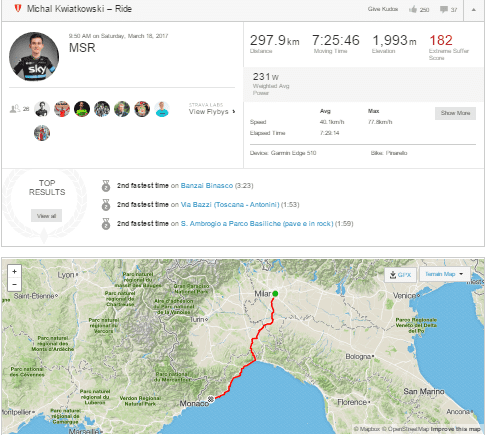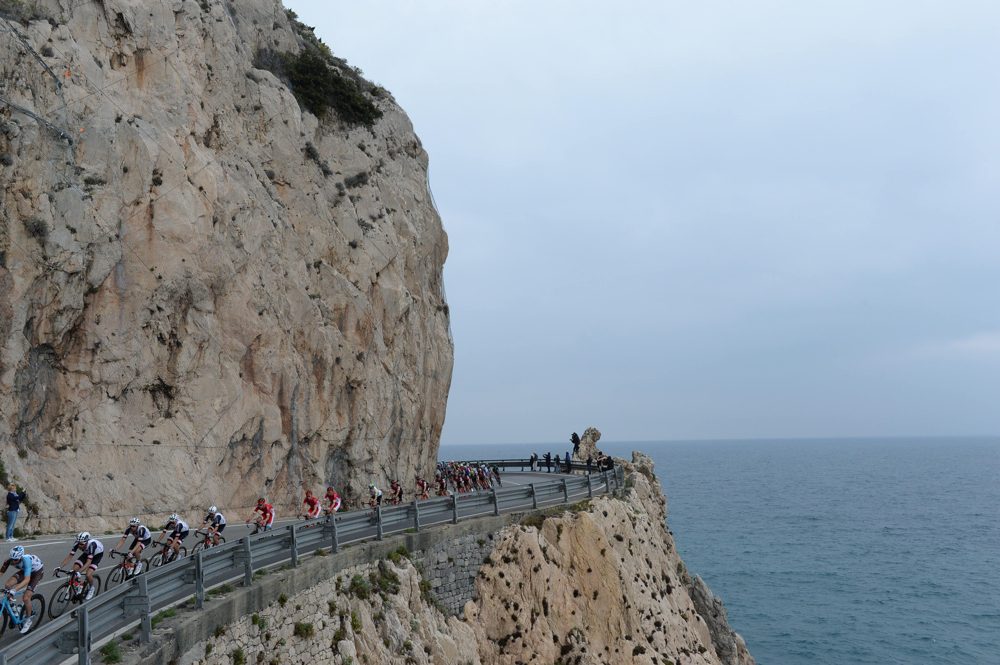Michal Kwiatkowski posts Milan-Sanremo winning ride on Strava with power
The immense effort required to follow a Sagan attack and win the longest race on the calendar

RELATED: Join Canadian Cycling Magazine on Strava
Peter Sagan’s attack on the Poggio in the finale of Milan-Sanremo put eventual winner Michal Kwiatkowski on the limit. The Polish former world champion who rides for Team Sky took his first Monument victory narrowly out-sprinting Sagan on the line when the race concluded after 291 km in Sanremo. It was the effort required to join Sagan on the Poggio along with Julian Alaphilippe that was the race’s decisive moment ensuring the 108th edition would not end in a bunch sprint as it has in the past four years. Kwiatkowski shared his race winning ride on Strava and chose to provide his power data from the immense effort as well.
Milan-Sanremo is the longest race on the UCI WorldTour calendar by almost 50 kilometres. After a long ride from the northern Italian city, the race hits the Mediterranean coast.
Kwiatkowski’s Strava ride starts with the neutral roll out. After a slow procession out of the heart of the city, the race flags dropped and the speed immediately ramped up. It was at this moment that the morning break of ten riders formed but after that initial effort the race became significantly easier. In the first 3-km the peloton raced along with an average speed of 48 kph but once the break went things slowed down considerably. In the races first four hours, Kwiatkowski rode with an average heart rate of 111 bpm. The only real obstacle on the way to the Mediterranean was the Passo del Turchino which came after 142 km of racing which provoked a modest effort that briefly raised Kwiatkowski’s heart rate to 176 bpm.
It’s during the run along the coast that the speed ramps up and the accumulated fatigue begins to set in. From the moment the peloton hit the coast with 138-km remaining to the time Kwiatkowski crossed the line, the winner’s average speed was 46 kph up from 36 kph in the first hours of racing.
However, things only really get serious in the final 28 km. The first obstacle was the Cipressa at 5.6-km long with an average gradient of 4.1 per cent. Kwiatkowski cleared the obstacle in 9:52 averaging 357 watts with a heart rate of 178 bpm. The peloton engulfed the morning break on the Cipressa.
With 9.4 km to go the race hit the final climb, the Poggio which is 3.6-km long with an average gradient of 3.7 per cent. It was on this climb that comes after 285 km of racing that the peloton snapped spurred on my Sagan’s attack. Kwiatkowski averaged 443 watts on his ascent of the Poggio which took 5:47 with an average heart rate of 181 bpm and average cadence of 99 rpm. The effort earned him the Strava KOM. It was with a kilometre left in the climb that Sagan attacked and to follow the world champion and Alaphilippe, Kwiatkowski averaged 612 watts with a max of 934 watts. Kwiatkowski also hit his maximum heart rate for the day hitting 190 bpm in the final metres of the climb.
After the descent Sagan, Alaphilippe and Kwiatkowski held an advantage of 17 seconds on the peloton. Only two kilometres of racing remained. Kwiatkowski took two brief turns at the front once on the flat run into the finish line. As the trio passed the flame rouge Sagan lead with Kwiatkowski second wheel. As Sagan rounded the final corner onto the Via Roma, Kwiatkowski waited until the current world champion opened up his sprint which he did from the front with 200 m to go. Kwiatkowski responded putting out a maximum of 1220 watts as he began to come around Sagan with 50 m to go hitting a max speed of 64 kph. All the fading Sagan could do was lunge for the line as in the closing 15 metres Kwiatkowski came around the rainbow jersey to take the win in a time of 7:08:39.




